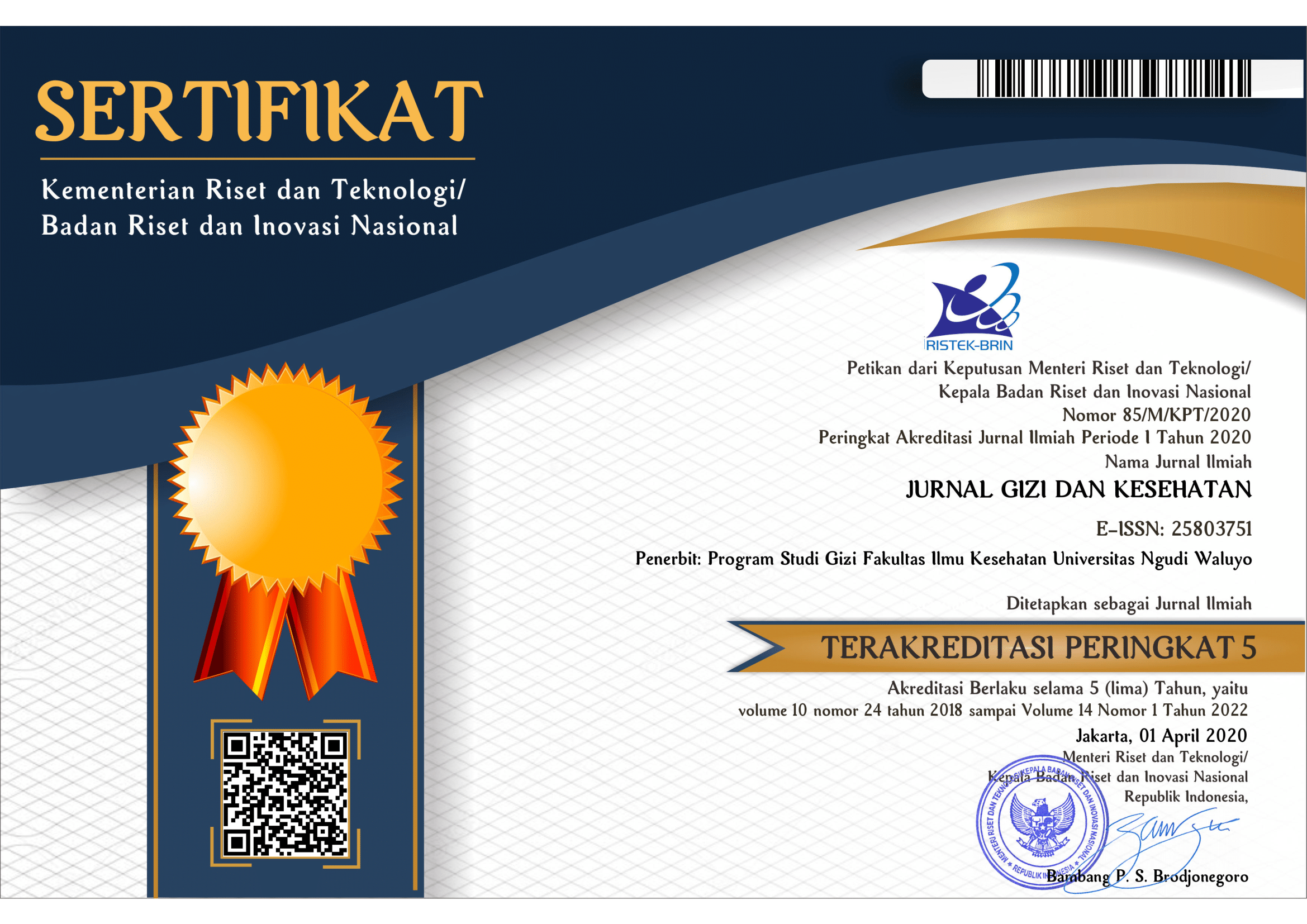The Acceptability of Tempeh Based Sausage Formulations with Natural Preservatives Addition
DOI:
https://doi.org/10.35473/jgk.v13i1.92Abstract
Sausage is a popular food for both children and adults. The main problem in sausage processing is their short shelf life. Synthetic preservatives such as nitrites are often added to sausage dough to extend the shelf life of sausages. Preservatives such as nitrites, if consumed too often can have harmful effects on health. The content of active compounds found in jasmine flowers is expected to be used as a source of natural preservatives in the processing of tempeh sausage in this study. This study aims to determine the acceptability of sausage formulations with the addition of natural preservatives. This study consisted of 3 treatments, namely tempeh sausage with extract variations of 0%, 0.1%, and 0.25%. This study used a completely randomized design (CRD). The concentration of jasmine flower extract had a significantly different effect on the taste of tempeh (p <0.05), where the higher the concentration of jasmine flower extract added to the tempeh sausage, the panelists' preference for the taste of the tempeh sausage would decrease. This is because the two basic ingredients of sausage, namely tempeh and jasmine flowers, already have a specific basic taste. The selection of preservatives made from natural ingredients can be a choice in developing food products, to minimize the use of synthetic preservatives in food products that are carcinogenic.
Keywords: Sausage, tempeh, preservatives
Downloads
References
Astuti, M. et al. (2000) “Tempe, a nutritious and healthy food from Indonesia,” Asia Pacific Journal of Clinical Nutrition. doi: 10.1046/j.1440-6047.2000.00176.x.
Azizah, N. et al. (2013) “Sifat Fisik , Organoleptik , Dan Kesukaan Yogurt Drink Dengan Penambahan Ekstrak Buah Nangka,” Jurnal Aplikasi Teknologi Pangan.
Bastian, F. et al. (2013) “Daya Terima dan Kandungan Zat Gizi Formula Tepung Tempe dengan Penambahan Semi Refined Carrageenan (SRC) dan Bubuk Kakao,” Jurnal Aplikasi Teknologi Pangan, Vol.2 No.1, hal. 5–8.
Brody, A. L. (2013) “The power of food packaging,” Food Technology.
Estiningtyas dan Rustanti (2014) “Kandungan Gizi Sosis Substitusi Tepung Tempe Dengan Bahan Pengisi Tepung Ubi Jalar Kuning (Ipomoea Batatas) Dan Bahan Penstabil Ekstrak Rumput Laut (Eucheuma Cottonii) Untuk Pmt Ibu Hamil,” Journal of Nutrition College. doi: 10.14710/jnc.v3i2.5118.
Herlina, D. (2015) “Penggunaan Tepung Glukomanan Umbi Gembili (Dioscorea esculenta l.) sebagai Bahan Tambahan Makanan pada Pengolahan Sosis Daging Ayam,” Jurnal Agroteknologi.
Jayalandri, N. L. G. L. et al. (2016) “Uji efektivitas ekstrak melati (Jasminum sambac) pada penyembuhan luka insisi kelinci (Oryctolagus cuniculus),” Jurnal e-Biomedik, 4(1). doi: 10.35790/ebm.4.1.2016.12487.
Kadi Kusumastuti, F. A. (2013) “Journal of nutrition education,” ournal of Nutrition College, Volume 2, Nomor 1, Tahun 2013, Halaman 27-34Online di : http://ejournal-s1.undip.ac.id/index.php/jnc*)Penulis Penanggungjawab, 2(11), hal. 27–34. doi: 10.1016/0002-8223(93)91990-8.
Larasati, K. (2018) “Analisis Kandungan Kadar Serat Dan Karakteristik Sosis Tempe Dengan Fortifikasi Karagenan Serta Penggunaan Tepung Terigu Sebagai Bahan Pengikat,” Jurnal Pendidikan Teknologi Pertanian. doi: 10.26858/jptp.v3i1.5199.
M.Tahir, M. (2017) “Aktivitas Antioksidan Dan Karakteristik Organoleptik Minuman Daun Sukun (Artocarpus Altilis) Dengan Penambahan Bunga Melati (Jasminum Sambac Ait.),” Journal of Agritech Science, 1(2), hal. 1–11.
Nur, H. H. dan Suryani, D. (2013) “Analisis Kandungan Nitrit Dalam Sosis Pada Distributor Sosis Di Kota Yogyakarta Tahun 2011,” Jurnal Kesehatan Masyarakat (Journal of Public Health), 6(1), hal. 1–12. doi: 10.12928/kesmas.v6i1.1062.
Nurjanah, R. (2018) “Pengaruh Suhu dan Lama Penyimpanan terhadap Kualitas Kentang Olahan (Solanum tuberosum L.) Kultivar Atlantik,” Jurnal Ilmu Pangan dan Hasil Pertanian, 1(2), hal. 1. doi: 10.26877/jiphp.v1i2.1678.
Odoni, D. I. et al. (2017) “Comparative proteomics of Rhizopus delemar ATCC 20344 unravels the role of amino acid catabolism in fumarate accumulation,” PeerJ. doi: 10.7717/peerj.3133.
Palandeng, feriana c. dan Lumoindong, F. (2016) “Karakteristik Fisiko-Kimia Dan Sensori Sosis Ayam Petelur Afkir Yang Difortifikasi Dengan Pasta Dari Wortel,” Jurnal Ilmu Dan Teknologi Pangan, 4(2), hal. 19–28.
Prayitno, A. H. et al. (2009) “Karakteristik sosis dengan fortifikasi β-caroten dari labu kuning (Cucurbita moschata),” Buletin Peternakan, 33(2), hal. 111–118.
Rusmin, D. et al. (2015) “Effect of Harvesting Time of White Big Ginger Seed Rhizome on Physiological Changes and Seed Viability during The Storage,” Jurnal Littri 21.
Sari, D. (2019) “Variasi Pengolahan Daya Terima Dan Kandungan Zat Gizi Keripik Tempe Rasa Bawang (Variations In Processing The Asseptability And Nutrient Content Of Onion Flavored Chips),” Jurnal Action, 4(4), hal. 1–6.
Sheih, I. C. et al. (2014) “Effects of fermentation on antioxidant properties and phytochemical composition of soy germ,” Journal of the Science of Food and Agriculture, 94(15), hal. 3163–3170. doi: 10.1002/jsfa.6666.
Sulthoniyah, T. D. dan Suprayitno, E. (2013) “Pengaruh Suhu Pengukusan Terhadap Kandungan Gizi dan Organoleptik Abon Ikan Gabus (Ophiocephalus striatus),” THPi Student Journal.
Susanti, K. dan Asyik, N. (2019) “Pengaruh Penambahan Sari Jahe Gajah (Zingiber 0fficinale) Terhadap Organolptik, Sifat Fisik Dan Kimia Dalam Pembuatan Permen Jelly Daun Katuk (Sauropus Androgynus),” J Sains dan Teknologi Pangan.
U.S. Department of Agricultural Research Service (2011) USDA National Nutrient Database for Standard Reference, Release 24, Database.
Wansink, B. dan Cheney, M. (2003) “Exploring comfort food preferences across age and gender,” Physiology and Behavior. doi: 10.1016/S0031-9384(03)00203-8.
Wulandari, D., Komar, D. dan Sumarlan, S. H. (2013) “Perekayasaan pangan berbasis produk lokal Indonesia (studi kasus sosis berbahan baku tempe kedelai),” Jurnal Bioproses Komoditas Tropis, 1(2), hal. 73–82.










